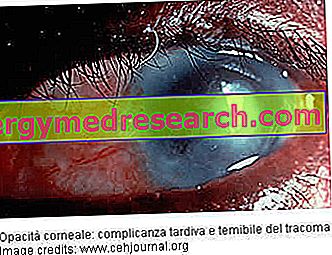Generality
Trachoma is the world's leading cause of blindness of infectious origin. Caused by the bacterium Chlamydia trachomatis, the disease is widespread and easily transmitted through direct contact with the eyes and nose of an infected person, or by sharing personal items, such as towels and clothing.

Trachoma mostly affects the poor and marginalized areas of the world, which do not have adequate access to drinking water and sanitary facilities.
Diagnosis
Active trachoma is often sub-clinical or asymptomatic: reconstruction of the patient's history reconstructs the evidence of clinical signs and provides information on the progression status of the disease. The following elements allow us to establish the possible contact with the disease pathogen:
- live in an area endemic to the infectious disease and have contact with family members of chronic trachoma or conjunctivitis;
- duration of 'eye irritation, acute follicular conjunctivitis or trichiasis;
- give an indication with respect to similar clinical episodes (active trachoma is often recurrent);
- presence of purulent secretion.
In areas where the disease is endemic, a doctor can diagnose trachoma through:
- physical examination : it allows to highlight the presence of clinical signs characteristic of various stages of the pathology. An eye exam can detect the follicles on the conjunctiva, inflammatory thickening, scars on the inside of the eyelid, redness of the white part of the eyes and the growth of new blood vessels in the cornea. Physical examination can also detect any signs of trichiasis or corneal opacity.
Laboratory diagnostic tests
- PCR analysis for Chlamydia DNA : identifies the infection (but does not provide diagnostic evidence for trachoma).
- Chlamydia cultural examination : microbiological culture of ocular secretions to accurately identify the infectious agent.
The cytological diagnosis involves the collection of conjunctival epithelial cells obtained through the scraping of the conjunctiva, and formations included in the cytoplasm (representing a stage of development of the microorganism) with a spatula and the consequent analysis of the material taken by:
- Direct immunofluorescence test of Chlamydia
- Giemsa coloring to search:
- basophilic intracytoplasmic bodies included in epithelial cells
- polymorphonuclear leukocytes
Prevention
Trachoma has been eliminated from much of the developed world in the last century, but persists in many parts of the developing world, particularly in communities without adequate access to drinking water and which do not have adequate sanitation facilities.
The improvement of environmental conditions, such as the use of drinking water, the control of insect vectors, the adaptation of sanitary facilities, health education and the proximity of pets are all proposed measures to reduce the transmission of the infectious agent .
The practices of proper hygiene are:
- Facial washing . Keep the face clean especially of children.
- Proper waste management . Avoid creating fertile ground for insects such as flies (they are one of the main vectors for disease transmission).
- Better access to water . Having a nearby source of drinking water can help improve hygienic conditions.
Although no vaccine is available, trachoma prevention is possible: it is important to have adequate sanitation facilities and to fight against insect vectors. Furthermore, it is important to avoid direct contact between infected carriers and healthy individuals.
The disease has almost disappeared even in some countries, such as Morocco, where health organizations have become active in the field of public education and have helped promote therapies known to treat the disease.
The eradication of trachoma (widespread at an endemic level) is a particular challenge. Under the guidance of the WHO, a worldwide initiative was launched in 1997 for the elimination of trachoma, called GET ( Global Elimination of Trachoma ), which aims to prevent and treat trachoma by controlling the disease through approaches health of the SAFE strategy . This strategy, based on scientific evidence, includes a complete package of interventions to reduce the transmission and consequences of the disease:
S - Surgery - eyelid surgery (for the treatment of advanced forms of trachoma);
A - Antibiotics - antibiotic therapy (to treat active infection basins, at the community level and prevent further spread of the causative agent);
F - Facial cleanliness - promote regular cleansing of the face with clean water (to reduce transmission of the disease); trachoma is transmitted through personal contact, it tends to occur in groups, families and communities. Children and women are particularly vulnerable to infections: the promotion of good hygiene practices, such as washing hands and washing the face of children, at least once a day with clean water, is a fundamental step to break the transmission cycle of the trachoma.
E - Environmental changes - environmental interventions (increase access to drinking water, adequate sanitation, control of vector insects).
The overall SAFE strategy combines measures for the treatment of active infection and trichiasis (S and A) with preventive measures to reduce transmission of the disease (F and E). This initiative aims to increase the effectiveness of international programs to contribute to the eradication of trachoma worldwide by 2020.
The F and E components of the strategy, which aim to act on the transmission of the disease, are particularly crucial to achieve the elimination of trachoma in endemic areas.
The WHO has been providing, since 2011, the collection of data on the prevalence of trachoma and the related mapping of the interventions necessary to understand the spatial epidemiology of the disease, identifying the areas where infection outbreaks persist.



